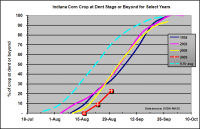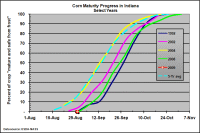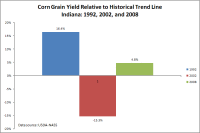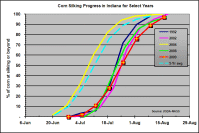1 Sep 2009
URL: http://www.kingcorn.org/news/articles.09/CropProgress-0901.html
Cool Days, Cold Nights, Slow Corn, What's Next?
R.L. (Bob) Nielsen
Agronomy Dept., Purdue Univ.
West Lafayette, IN 47907-2054
Email address: rnielsen
at purdue.edu

Fig. 1. Corn denting progress in
Indiana for select years. Click image
for larger version.

Fig. 2. Corn maturity progress in
Indiana for select years. Click image
to view larger version.

Fig. 3. Corn grain yield relative to
historical trend line for Indiana in
1992, 2002, and 2008. Click on
image to view larger version.

Fig. 4. Kernel black layer dates vs.
silking dates for two hybrids at two
locations in 1992. Collaborative
research between Purdue/Ohio State.
Click on image to view larger version.

Fig. 5. Corn silking progress in
Indiana for select years. Click image
to view larger version.
![]() he good news is that most of Indiana's late-planted corn crop escaped serious heat or drought stress during the critical pollination period and, to date, much of the important grain filling period. The discouraging news is that the unusually cool 2009 growing season continues to put the brakes on the development of the crop. According to the most recent weekly USDA crop progress report, the majority of the state's crop has progressed through the dough stage of development (R4) and is moving toward the dent stage (R5), but now lags nearly 3 weeks behind the 5-year average progress (Fig. 1). If the current rate of crop progress continues for the remainder of the season, quite a bit of the state's crop will mature in October rather than September (Fig. 2).
he good news is that most of Indiana's late-planted corn crop escaped serious heat or drought stress during the critical pollination period and, to date, much of the important grain filling period. The discouraging news is that the unusually cool 2009 growing season continues to put the brakes on the development of the crop. According to the most recent weekly USDA crop progress report, the majority of the state's crop has progressed through the dough stage of development (R4) and is moving toward the dent stage (R5), but now lags nearly 3 weeks behind the 5-year average progress (Fig. 1). If the current rate of crop progress continues for the remainder of the season, quite a bit of the state's crop will mature in October rather than September (Fig. 2).
Recent night-time low temperatures in the low to mid-40's F have certainly increased growers' concerns about the prospects for successfully maturing this crop and whether these unusually cool temperatures will impact grain yield. Unfortunately, the effects of such an unusually cool grain filling period on corn maturity dates and yield in the central Corn Belt are not well known, partly because the historical occurrence of such unusually cool grain filling periods is so infrequent.
In an earlier article I referenced the similarity between this season's slow pace of crop development with three earlier years of 1992, 2002, and 2008 (Fig's 1 and 2). Though crop progress in those three growing seasons were similarly delayed, the end result for grain yields varied dramatically (Fig. 3). In my judgement, the 2009 growing season is more similar to the 1992 and 2008 growing seasons than to the disastrous 2002 growing season. Drought stress accompanied the delayed crop development in 2002 and contributed strongly to the large decrease from trend yield that year. Indiana's corn crop has not experienced such widespread drought stress in 2009. The USDA-NASS certainly believes that yields will be good this year, according to their first yield estimate released 12 Aug that pegs Indiana's 2009 corn crop at 163 bu/ac or 5.6% above trend yield.
Nevertheless, the recent weeks of cool weather accentuated with the recent nights of temperatures in the low to mid-40's F have fueled vigorous debates amongst the regulars down at the Chat 'n Chew Cafe about how the crop will respond. Moderate temperatures and adequate moisture during the grain fill period are generally favorable for kernel set success and kernel weight development. However, it is true that temperatures as low as 50F or lower can be detrimental to the photosynthetic processes. Canadian researchers Ying et al. (2000) documented that photosynthetic rates in corn decreased by 18 to 30% the day following a cold temperature stress of about 40F during grain filling. The more important question is whether multiple days of cold temperature stress during grain filling can cause longer-term reductions in photosynthetic rates that may actually lead to a premature senescence and development of kernel black layer. There is limited research that addresses this question.
Observations over the years, though, lead me to believe that there comes a point late in grain fill where extended periods of cool temperatures cause the plant to slowly shut down even though no actual frost injury has occurred. These observations are in agreement with those of Daynard (1972) who suggested that extended periods of cool temperatures, not frost, were a more probably cause of what he characterized as "premature" black layer development. He noted that kernel black formation occurred shortly after cold spells when the average daily MAXIMUM temperatures were 54F or cooler. The good news, to date, is that we have yet to experience such low daily MAXIMUM temperatures.
Our own research from 1992 offers us a hint of what to expect on the calendar timing of kernel black layer formation (i.e., physiological maturity) relative to the silking date (Fig. 4). The data shown in Fig. 4 are from two adapted hybrids grown at two locations (westcentral IN and southwest OH) in 1992 and represent a subset of data collected from 1991 through 1994 in our studies on the effect of delayed planting on thermal requirements of corn (Nielsen et al., 2002).
For planting dates where silking occurred towards late July, kernel black layer formation occurred by 21 September. Where silking occurred in early August, kernel black layer occurred by 11 October. Where silking occurred about mid-August, kernel black layer formation occurred by 27 October, but occurred 10 to 14 days AFTER a killing freeze event. All of the earlier silking dates (late July and early August) successfully reached kernel black layer prior to a killing freeze. Given the similarities between 1992 and 2009, I suggest that these data represent something of a crystal ball for us to gaze into for this year's crop.
So, what can we say about the fall freeze risk to this year's crop? We know that USDA-NASS estimated that 76% of Indiana's corn crop had silked by 2 Aug (Fig. 5). Our previous research suggests that most of that should black layer no later than early October. Another 13% of the crop had silked by 9 Aug and that may black layer by approximately 11 Oct. Much of the remainder of the state's crop (8 to 11%) had silked by 16 Aug or later. That portion of the crop may not mature until late October to early November AND will likely experience a killing fall freeze PRIOR to normal kernel black layer formation. Assuming that the tail end of this year's crop will at least make it to the half-milkline stage of development prior to a killing freeze, the potential yield loss for an individual field due to premature plant death would be no more than 12% (Afuakwa & Crookston, 1984).
Related References
Afuakwa, J. J. and R. K Crookston. 1984. Using the kernel milk line to visually monitor grain maturity in maize. Crop Sci. 24:687-691.
Daynard, T.B. 1972. Relationships among black layer formation, grain moisture percentage, and heat unit accumulation in corn. Agron. J. 64:716-719.
Nielsen, R.L. (Bob). 2008. Grain Fill Stages in Corn. Corny News Network, Purdue Univ. [online] http://www.kingcorn.org/news/timeless/GrainFill.html [URL accessed 8/31/09].
Nielsen, R.L. (Bob). 2009. A Tale of Three Cropping Seasons. Corny News Network, Purdue Univ. [online] http://www.kingcorn.org/news/articles.09/CropProgress-0803.html [URL accessed 9/1/09].
Nielsen, R.L. (Bob). 2009. Effects of Stress During Grain Filling in Corn. Corny News Network, Purdue Univ. [online] http://www.kingcorn.org/news/timeless/GrainFillStress.html [URL accessed 9/1/09].
Nielsen, R.L., P.R. Thomison, G.A. Brown, A.L. Halter, J. Wells, & K.L. Wuethrich. 2002. Delayed Planting Effects on Flowering and Grain Maturation of Dent Corn. Agron. J. 94:549-558.
USDA-NASS. 2009. Crop Production. USDA National Ag. Statistics Service. [online] http://usda.mannlib.cornell.edu/usda/nass/CropProd//2000s/2009/CropProd-08-12-2009.pdf [URL accessed 9/1/09].
USDA-NASS. 2009. Crop Progress. USDA National Ag. Statistics Service. [online] http://usda.mannlib.cornell.edu/MannUsda/viewDocumentInfo.do?documentID=1048 [URL accessed 8/31/09].
Ying, J., E.A. Lee, and M. Tollenaar. 2000. Response of maize leaf photosynthesis to low temperature during the grain-filling period. Field Crops Research 68:87-96.

